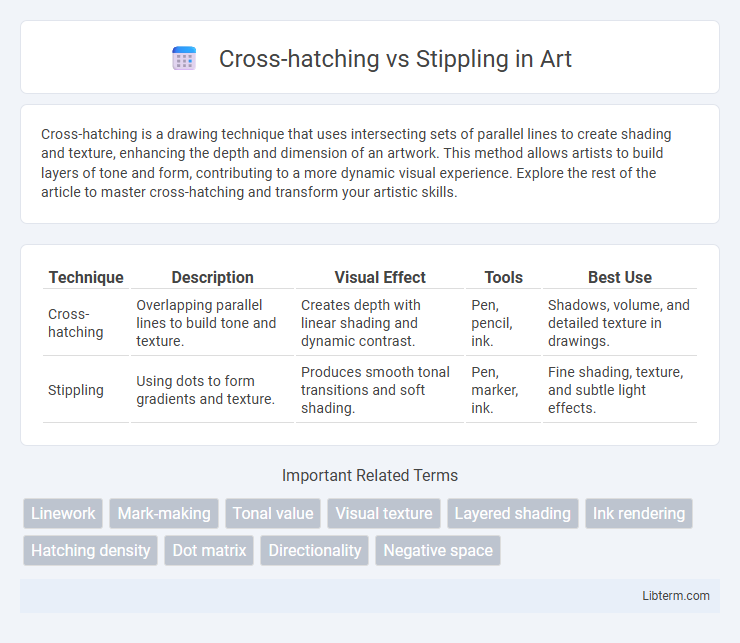Cross-hatching is a drawing technique that uses intersecting sets of parallel lines to create shading and texture, enhancing the depth and dimension of an artwork. This method allows artists to build layers of tone and form, contributing to a more dynamic visual experience. Explore the rest of the article to master cross-hatching and transform your artistic skills.
Table of Comparison
| Technique | Description | Visual Effect | Tools | Best Use |
|---|---|---|---|---|
| Cross-hatching | Overlapping parallel lines to build tone and texture. | Creates depth with linear shading and dynamic contrast. | Pen, pencil, ink. | Shadows, volume, and detailed texture in drawings. |
| Stippling | Using dots to form gradients and texture. | Produces smooth tonal transitions and soft shading. | Pen, marker, ink. | Fine shading, texture, and subtle light effects. |
Introduction to Cross-Hatching and Stippling
Cross-hatching and stippling are fundamental drawing techniques used to create texture, shading, and depth in artwork. Cross-hatching involves layering intersecting sets of parallel lines to build tonal variations, while stippling uses numerous small dots to achieve gradual shading and detail. Both methods enhance dimensionality and contrast, offering artists versatile options for expressive line work and intricate surface rendering.
Defining Cross-Hatching: Techniques and Styles
Cross-hatching is a drawing technique that uses intersecting sets of parallel lines to create texture, tonal variation, and depth. Artists vary line direction, spacing, and density to achieve different shading effects and styles, ranging from loose and sketchy to precise and detailed. This method is widely used in pen and ink drawings to build gradients and enhance dimensionality.
Stippling Explained: Principles and Methods
Stippling involves creating images through numerous small dots, varying density to achieve shading and texture, allowing precise control over tonal gradations. The fundamental principle relies on the concentration and spacing of dots to simulate light and shadow, producing a highly detailed and textured appearance. Common methods include using fine-tipped pens or needles on various surfaces, with stippling often favored for its ability to render subtle depth and rich visual complexity compared to line-based techniques like cross-hatching.
Historical Origins of Each Technique
Cross-hatching originated in the Renaissance period, widely used by artists like Albrecht Durer to create depth and texture through intersecting lines. Stippling dates back to ancient times but was refined during the 18th century, notably in engraving and printmaking, using dots to achieve tonal variation. Both techniques evolved to enhance shading in drawing and print art, reflecting distinct historical practices across European art traditions.
Comparing Visual Effects: Texture and Depth
Cross-hatching creates texture and depth by layering intersecting lines at varying angles, producing a rich gradient that enhances dimensionality in drawings. Stippling builds visual effects through numerous small dots, allowing for subtle tonal transitions and a softer texture that can mimic shading with delicate precision. Both techniques manipulate light and shadow to achieve depth, but cross-hatching emphasizes linear structure while stippling offers a more granular, nuanced surface detail.
Tools and Materials for Both Methods
Cross-hatching and stippling techniques require specific tools and materials to achieve distinct textural effects. Cross-hatching often utilizes fine-tipped pens, pencils, or graphite to create overlapping lines, while stippling depends on fine-point pens or brushes to place individual dots precisely. Both methods benefit from high-quality, smooth paper designed to hold ink or graphite without bleeding or smudging, ensuring clarity and control in the artwork.
Strengths and Limitations: Cross-Hatching vs Stippling
Cross-hatching excels in creating depth and texture quickly through overlapping lines, making it ideal for detailed shading and dynamic contrast in drawings. Stippling offers precise control over tonal gradients by varying dot density, resulting in smooth transitions and fine detail suited for delicate or intricate artwork. However, cross-hatching can sometimes produce a harsher appearance with visible line patterns, while stippling is time-consuming and may lack the boldness needed for strong visual impact.
When to Use Cross-Hatching or Stippling
Cross-hatching excels in creating depth and texture with varied line intensity, making it ideal for shading larger surfaces and depicting dramatic light contrasts. Stippling is best suited for subtle tonal gradients and delicate textures, often used in botanical or scientific illustrations requiring precision. Choose cross-hatching for dynamic, expressive shading and stippling when precise, controlled detail and gradual tone shifts are needed.
Mastering Both Techniques: Tips for Artists
Mastering both cross-hatching and stippling enhances an artist's ability to create texture and depth through varied shading methods. Cross-hatching uses intersecting lines to build tone intensity and volume, while stippling employs countless dots to achieve subtle gradients and intricate detail. Practicing consistent mark spacing, varying pressure, and studying light sources can significantly improve precision and realism in these foundational drawing techniques.
Conclusion: Choosing the Right Technique for Your Artwork
Cross-hatching offers dynamic shading with varied line density, ideal for creating depth and texture in intricate illustrations, while stippling provides subtle tonal variation through precise dot placement, perfect for detailed, gradual transitions. Selecting the right technique depends on the desired visual effect, medium, and time investment, with cross-hatching allowing faster coverage and stippling demanding patience for meticulous detailing. Artists should consider the emotional tone and style of their piece, as cross-hatching conveys energy and movement, whereas stippling emphasizes softness and careful craftsmanship.
Cross-hatching Infographic

 libterm.com
libterm.com